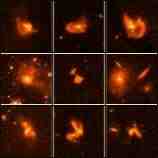January 22, 2001
Galaxies, systems of stars, interstellar gas, and interstellar dust all bound together by gravity, range from dwarf galaxies of a million stars to supergiant galaxies with over 10^(12) stars.
During this century, our views concerning galaxies other than our own have undergone considerable revision. ... ... R. Genzel et al present a review of recent work on galaxy collisions, and the authors make the following points: 1) Not until 1920 was it established that "galaxies" are large concentrations of stars and interstellar gas like our Milky Way, but located large distances away.
Until the mid 1950s, the accepted view was that galaxies are "island universes" very much isolated from each other. 2) In 1956, The astronomer Fritz Zwicky called attention to filaments and jets of stars in adjacent galaxies, and he suggested these could be large scale "tidal effects" due to the galactic mutual gravitational interaction.
But Zwicky's interpretation met with widespread skepticism until numerical models indicated the slow but close passage of two galaxies can create long tails, bridges, and spiral structures purely as the result of the gravitational forces and torques between the two colliding galaxies. 3) The consensus view of galaxies changed after the mid-1980s as a result of the first space-borne *infrared telescope (IRAS), which surveyed the entire sky in the 12 to 120 micron band.
Although most of the several tens of thousands of galaxies identified by IRAS are normal galaxies like our own Milky Way, there are also now hundreds of identified galaxies whose total energy output is dominated by emission in the far infrared band, and the most spectacular of these are the ultra-luminous infrared galaxies, which have luminosities resembling that of extreme *active galactic nuclei such as quasars.
Recent observations have established that most of these ultra-luminous infrared galaxies are extreme interacting systems with strong signatures of recent tidal disturbances, in some cases showing that the two galaxies are actually close to merging into a single system.
The key questions are, a) Why is there such a strong correlation between infrared luminosity and galaxy interaction? b) What powers these galaxies (active star formation or black holes)?, and c) How are these galaxies evolving with time? The authors summarize: "It is becoming increasingly clear that collisions between galaxies play an important role in galaxy evolution. The ultraluminous infrared galaxies are predominantly powered by enormous star-formation events that are triggered in the last phases of such collisions. These bursts occur just before the galaxies merge to form single elliptical galaxies."
R. Genzel et al (Max Planck Institute for Extraterrestrial
Physics Garching, DE)
Star formation triggered by galaxy collisions.
(Nature 29 Oct 98 395:859)
QY: Reinhard Genzel, Max-Planck Institut fur Extraterrestrische
Physik, 85740 Garching, DE.
Text Notes:
*infrared telescope:
Infrared radiation involves wavelengths between the red end of the visible spectrum and the radio bands of the spectrum, from about 0.8 microns to about 1000 microns. The submillimeter infrared band lies between the far-infrared band (at about 0.1 millimeter) and the microwave band (above 1 millimeter). Submillimeter wavelengths trace directly the emission from dust that has been warmed by massive star-formation activity.*nuclei:
Central regions of galaxies in which considerable energy is generated by processes other than those operating in ordinary stars. The energy may result from the accretion of material into a massive black hole situated at the core of the galaxy.*quasars: (quasi-stellar objects):
Extremely luminous sources radiating energy over the entire spectrum from x-rays to radio waves, and which are apparently the oldest and most distant objects in the universe. They are believed to involve massive *black holes*black holes:
If the terminal stages of star death leave a remnant star mass greater than 3 solar masses, the ultimate gravitational collapse will produce a "black hole", a relativistic singularity. A black hole is a localized region of space from which neither matter nor radiation can escape. The "trapping" occurs because the requisite escape velocity, which can be calculated from the relevant equations, exceeds the velocity of light and is therefore unattainable. Another view of a black hole is that it is a mass that has collapsed to such a small volume that its gravity prevents the escape of all radiation. If quasars indeed involve black holes, the radiation is from material just outside the black hole, and not from anything within it. Nothing inside a black hole can get out of it.*elliptical galaxies:
In 1925, the astronomer Edwin Hubble introduced a classification scheme for galaxies that is now widely used. The scheme has 3 main types of galaxy: elliptical, spiral, and barred spiral, and each is further divided into morphological subtypes. Elliptical galaxies are apparently composed of old stars, contain little dust, are the central dominant galaxies in rich clusters, and many are powerful sources of radio wavelength radiation. The size of elliptic galaxies ranges from dwarf ellipticals (10^(8) stars) to supergiant ellipticals (10^(13) stars). Elliptical galaxies are believed to be a stage in the evolution of galaxies, and different cosmological models make specific predictions about the number of elliptical galaxies as a function of redshift. In principle, therefore, observations of elliptical galaxies can be used to discriminate between models.
EVOLUTION OF GALAXIES
Education 2001 - HowComYouCom.com
